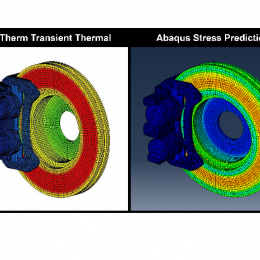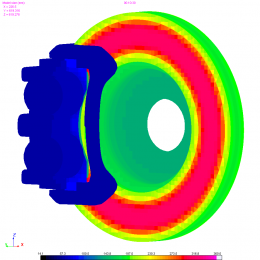 Brake Composite
Brake CompositeAutomotive manufacturers are constantly looking to improve performance, quality, efficiency and safety of the cars they make. They face both consumer pressures for design improvement and innovation as well as regulatory pressures from the federal government that mandates increasing fuel efficiency standards. There may be no better recipe for success than analysis and modeling, and this is certainly the case when it comes to improving thermal management of brake systems.
The Case for Thermal Modeling Brakes
Your car’s brakes are often under constant strain from heat. This heat can be managed in one of two ways: 1) dissipation and/or 2) storage. Either the heat flows in some manner, or it is safely absorbed as energy or thermal inertia within the braking system to be dissipated later. When either is not done properly, the braking system deteriorates prematurely or in unpredictable ways.
The consequences for not first understanding — and later mitigating — how a brake system will react to extreme heat can range from underperformance of the brakes to “wear and tear” on the components…or, in extreme cases, perhaps even brake failure!
 Brake System
Brake SystemModeling the performance of a brake system in the design phase, if done completely and correctly, will identify any potential thermal issues long before they were to occur, and even before the brake system is manufactured. By doing so, the manufacturer prevents not only liability or dissatisfaction from future car owners with underperforming brakes, but they save considerable time and cost throughout the design cycle in some obvious — and some not so obvious — ways.
One of the many benefits of using sophisticated technology to analyze and model real-world scenarios is the ability to “virtual prototype” — emulate real-world conditions via computer simulation so that you cover all of the important design space and operating scenarios — which are not tractable with physical prototypes and testing. Accurate modeling protects a carmaker from the implicit need to “over design” or “over manufacture,” which directly saves on material costs in the manufacturing of components, including brakes.
If you’re not over-designing, you’re not over-manufacturing; and bit by bit, component by component, you’re shaving off material costs and reducing weight, that in the aggregate can be significant difference makers in an OEM’s quest to meet those ever-moving fuel efficiency standards.
Real-World Modeling for Real-World Reliability
Not all modeling tools are the same. Many traditional modeling tools rely on simplistic assumptions for modeling the actual performance of a car’s brake system as it will occur in the real world. As a result, they return incomplete or inaccurate data and can cause a designer to over-design … or even under-design!
Some common mistakes that can be made in the modeling process include:
Relying on steady-state analysis, when transient analysis is required. In the real world things are dynamic, we take our cars for quick trips one day and long treks another, during which braking intervals can vary widely. The amount of time between significant braking events can have a dramatic effect on how a braking system manages heat spikes. Traditional tools typically don’t account for these real-world, transient variances … so they aren’t really modeling real-world dynamic situations.
Not taking a multi-physics approach. There are, concurrently, many factors affecting the heating and cooling of brake systems, including the conduction of frictional heating through the brake components as brakes are applied, the radiation of heat between nearby objects, and airflow convection that can have a cooling effect. Conventional modeling tools may not fully account for all of these factors, so obtaining a robust analysis may require co-simulation through the coupling of multiple tools to fully simulate the entire braking process. Anything less than full simulation could result in design deficiencies.
Using a one-dimensional tool to simulate a 3-D problem. Whether it’s the way heat radiates through multiple paths, is conducted along different axes, or is dissipated via complex airflow, heat is very much a three-dimensional phenomenon. It’s nearly impossible to accurately simulate heat performance with 1-D modeling software.
Modeling Early and Often
The earlier in the concept design phase of a braking system that you start your modeling and analysis, the greater the probability of success during the actual design-engineering phase. The earlier you start, the more complete and the more accurate your understanding will be of the actual performance of the brake in the real world. We like to think that it’s never too early to see the entire picture.
Counter to what some believe, introducing full three-dimensional, transient analysis into the design phase actually saves time and cost, as it allows the engineering team to perform “virtual prototyping” that identifies issues and opportunities before a braking component is even built — in other words, before significant design and material costs are incurred.
A brake system undergoes significant, continuous and ever-changing heat stress during a normal drive cycle in the real world. Modeling that stress accurately, early and often will save time and costs in the short term, save the lifespan of the braking system in the long term, and perhaps even save lives in the extreme.
If nothing else, getting smarter about design choices through analysis and modeling will help manufacturers make more educated decisions about how and where to make weight and material decisions in the braking systems to meet their enterprise-wide commitment to meeting increasingly demanding fuel efficiency standards and safety requirements.
Learn more about the benefits of performing three dimensional transient analysis on automotive braking systems, and the proprietary TAITherm system.
